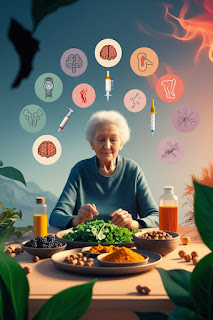Understanding misleading health advice in modern medicine, dietetics, and alternative therapies—and how to protect yourself with science-backed knowledge
By Brian S
Discover the truth behind health misinformation and disinformation from modern medicine, nutrition, and alternative medicine. Learn how to recognize false claims, why they spread, and how to make informed health decisions based on science.
Health Misinformation and Disinformation: What Are They?
In today’s digital world, health advice spreads fast—but not always accurately. With the rise of social media and wellness influencers, the boundaries between evidence-based medicine, outdated beliefs, and pseudoscience have become increasingly difficult to discern.
Two terms often used in this context are misinformation and disinformation. Though similar, their origins and intentions differ, and understanding these distinctions is crucial to protecting your health and the health of others.
Defining Misinformation and Disinformation
-
Misinformation is incorrect or misleading health information shared without intent to deceive. It usually stems from ignorance or misunderstanding.
-
Disinformation, on the other hand, is intentionally misleading or false information disseminated for political, ideological, or financial gain (Wardle & Derakhshan, 2017).
Both can cause harm—especially when adopted by the public or spread by trusted figures, including doctors, dietitians, and alternative healers.
How Misinformation and Disinformation Spread in Health Fields
Though we often associate misinformation with social media or fringe practitioners, it exists across the spectrum of healthcare, from hospital corridors to herbal shops. Below, we explore real examples from:
- Modern Medicine
- Modern Dietetics
- Alternative Medicine
Misinformation: Antibiotics for Viral Infections
Even today, some physicians prescribe antibiotics for viral illnesses such as the common cold or flu, despite decades of warnings. This contributes to antibiotic resistance, an issue the World Health Organization (2023) calls "one of the biggest threats to global health" ([WHO, 2023]).
Disinformation: Suppressed Drug Trial Data
A glaring example of disinformation was the Vioxx scandal. Merck marketed rofecoxib as a safe anti-inflammatory while withholding internal data showing increased risks of heart attack and stroke (Graham, 2005). It is estimated that over 60,000 people died before the drug was pulled from the market.
“What made this scandal so egregious is that data suppression was deliberate. Profit was prioritized over life.” (Graham, 2005)
2. Modern Dietetics: Misguided Guidelines and Industry Manipulation
Misinformation: The Low-Fat Craze
For decades, health authorities promoted low-fat diets as universally healthy. This led to an increase in sugar and refined carbohydrate intake, correlating with the rise of obesity and Type 2 diabetes (Ludwig et al., 2018). The intention may have been good, but the consequences were tragic.
Disinformation: The Sugar Industry Cover-up
In the 1960s, the sugar industry funded research that minimized sugar’s role in heart disease while blaming saturated fat—a move that shaped decades of dietary policy (Kearns et al., 2016). The deception remained hidden until recently.
“The Sugar Research Foundation paid Harvard scientists to shift the blame from sugar to fat—compromising public health for decades” (Kearns et al., 2016).
3. Alternative Medicine: Natural Myths and Exploitation
: “Natural Means Safe”
Many believe that herbal remedies and traditional therapies are inherently safe. But natural doesn’t mean risk-free. Herbs like comfrey, kava, and aristolochic acid have been linked to liver damage and cancer, especially when misused or taken with pharmaceuticals (FDA, 2022).
Disinformation: Miracle Cure Scams
Certain figures in the alternative health space promote unproven “miracle cures” for cancer—such as black salve or laetrile (vitamin B17)—with no scientific backing. These often exploit desperate patients, delaying or replacing effective treatment (FTC, 2021).
“Deceptive marketing of natural cancer cures has been an ongoing problem... patients are at real risk of harm” (FTC, 2021).
How to Avoid Falling for False Health Information
1. Be Skeptical of Emotional or Sensational Claims
- “Doctors don’t want you to know…”
- “Secret cure Big Pharma is hiding…”
- “One miracle herb that heals everything…”
These are all red flags of manipulation.
2. Examine the Source
- Does the speaker have medical or scientific credentials?
- Are they quoting peer-reviewed research?
- Are they trying to sell you something?
3. Look for Scientific Consensus
Individual studies may mislead. Look for systematic reviews, meta-analyses, or statements from independent bodies like WHO, Cochrane, or PubMed-indexed journals.
4. Cross-Check with Reputable Databases
Use:
- PubMed
- Cochrane Library
- CDC/WHO websites
- Academic journals
5. Stay Humble—Science Evolves
Knowledge is dynamic. What’s “true” today may be revised tomorrow. Be willing to update your beliefs based on emerging evidence.
Conclusion: Knowledge Is Your Best Defense
In the war against health misinformation and disinformation, the best armor is critical thinking and scientific literacy. By questioning what we hear, checking our sources, and understanding the complexity of health science, we can make better decisions—not just for ourselves, but for our communities.
Whether you're reading a scientific journal, a wellness blog, or a friend’s Facebook post—always ask, verify, and think critically. Health is too important to be left in the hands of half-truths.
References
- FDA. (2022). Herbs and Safety. U.S. Food & Drug Administration. Available at: https://www.fda.gov
- FTC. (2021). FTC Cracks Down on Bogus Cancer Cures. Federal Trade Commission. Available at: https://www.ftc.gov
- Graham, D. (2005). 'COX-2 inhibitors, other NSAIDs, and cardiovascular risk: the seduction of common sense'. The Lancet, 365(9450), pp. 2021–2022.
- Kearns, C.E., Schmidt, L.A. and Glantz, S.A. (2016). ‘Sugar Industry and Coronary Heart Disease Research: A Historical Analysis of Internal Industry Documents’. JAMA Internal Medicine, 176(11), pp. 1680–1685.
- Ludwig, D.S., Willett, W.C., Volek, J.S. and Neuhouser, M.L. (2018). ‘Dietary fat: From foe to friend?’. Science, 362(6416), pp. 764–770.
- Wardle, C. and Derakhshan, H. (2017). Information Disorder: Toward an interdisciplinary framework. Council of Europe Report.
- WHO. (2023). Antibiotic resistance. World Health Organization. Available at: https://www.who.int
Copyright © 2025 www.zentnutri.blogspot.com. All Rights Reserved.












